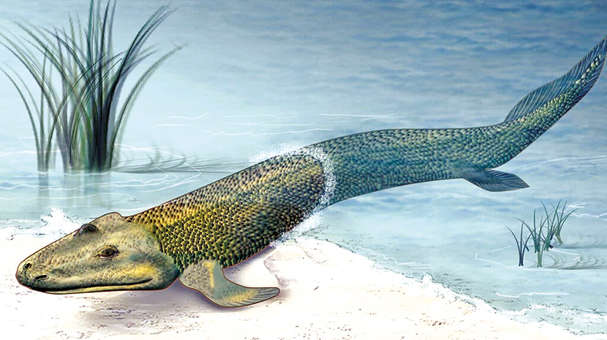Started out as a fish. How did it end up like this?
Tiktaalik first became known to humans in 20a04, after skulls and other bones of at least 10 specimens turned up in ancient stream beds in the Nunavut Territory of the Arctic.

It may not be the worst of times, but it is certainly not the best of times. The pandemic has no end in sight. The world is warming, the seas are rising and polar bears are barrelling toward extinction. Also: taxes, the 9-to-5 workweek, the renewed threat of nuclear war.
As people looked for someone to blame besides themselves and all of humanity, a culprit emerged in the form of a fish, specifically the 375-million-year-old Tiktaalik (pronounced tic-TAH-lick). Our modern woes would never have existed if our ancestors had never left the water, the reasoning went. Tiktaalik’s four whispers of feet made the fish an easy target.
In 2006, the artist Zina Deretsky made a scientific illustration of Tiktaalik for the National Science Foundation. More recently her depiction of Tiktaalik as a pensive-looking fish poised to leave the water has become the foundation for a flood of memes. In one, the fish is met with medieval polearms and premonitions: “If you see a Horrid Beast evolving, PUSH IT BACK IN.” The memes yearn to thwack Tiktaalik with a rolled-up newspaper or poke it with a stick — anything to shoo it back into the water and avoid our having to go to work and pay rent.
When Deretsky first saw one of the memes riffing on her Tiktaalik illustration, she felt she could commiserate. “Our world is a little bit difficult right now,” she said. Scientists may never know exactly why fish like Tiktaalik and early tetrapods — vertebrates with four limbs — moved onto land, said Alice Clement, an evolutionary biologist and paleontologist at Flinders University in South Australia. “Was it to seek out more food, escape predators in the water, find a safe haven for their developing young?” Dr. Clement asked. Regardless, their legacy is enormous. The group of fish that moved onto land gave rise to almost half of all vertebrates today, including all amphibians, reptiles, birds, mammals and us. And although we probably cannot trace our family tree directly back to Tiktaalik, “an animal very much like Tiktaalik was a direct ancestor of humans,” said Julia Molnar, an evolutionary biomechanist at the New York Institute of Technology.
If Tiktaalik is our ancestor, then perhaps our holding it accountable for the chaos it sowed is an expression of love.
Tiktaalik first became known to humans in 2004, after skulls and other bones of at least 10 specimens turned up in ancient stream beds in the Nunavut Territory of the Arctic. The discoverers, a team of paleontologists including Neil Shubin of the University of Chicago, Ted Daeschler at the Academy of Natural Sciences in Philadelphia, and Farish Jenkins of Harvard University, described their findings in two Nature papers in 2006. A local council of elders known as the Inuit Qaujimajatuqangit Katimajiit were consulted, and they gave Tiktaalik its name, which translates to a large freshwater fish that lives in the shallows, in Inuktitut. The fossils have since been returned to Canada.
When Deretsky illustrated Tiktaalik, she portrayed it with its derrière submerged in water, as the fossil’s back half was a mystery at the time. But in the years since, scientists have amassed more than 20 specimens and seen more of its anatomy, including its pelvis, hind fin and the joints of its skull.
Visit news.dtnext.in to explore our interactive epaper!
Download the DT Next app for more exciting features!
Click here for iOS
Click here for Android



